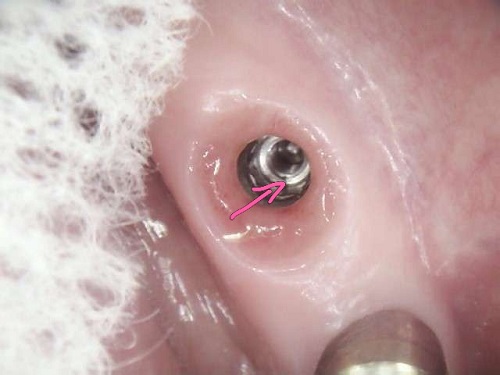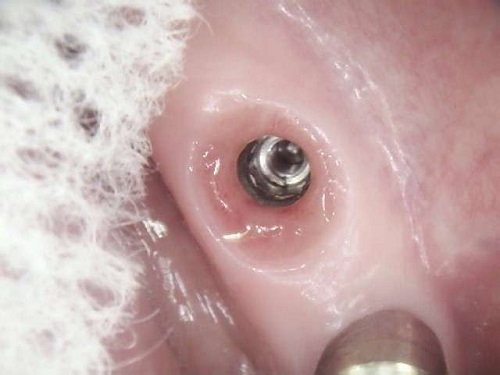I placed an implant at #19 about 3.5 months ago for a 67-year old female relative. We just found out that the hex internal connection of #19 implant has a crack since the impression coping couldn't engage or stable. NO soft tissue or bone tissue is blocking it.
In this case, what is the best way to remove it? Is it still possible to take it out with a reverse torque? Or can we just leave the implant in the socket with no crown loading, and place another implant at #18 socket? There is no inflammation detected right now.
Appreciate all suggestions.



Dr. Rayment comments:
That is really unfortunate. Someone did a wonderful job placing those implants and the tissue health is fantastic. There is no way you can reverse that out, it is well integrated, and any attempt to remove this implant will be fairly destructive. I buried a Zimmer implant that "flowered" at the top of the platform in the #12 position with a cover screw and restored around it with a fixed bridge from #11-x-13. Best of luck. This always happens to "family" doesn't it?
Tim_du_78 comments:
Dr. Rayment, Thank you for your opinion and sharing your experience. Did you do a gingival surgery or just suture it for the #12? This 5mm implant has a 6mm (width) healing abutment and patient's gingiva is about 1.5mm in thickness. If I bury the implant with a cover screw, will it be covered by gingiva later without a soft tissue graft?
Delicate Olive comments:
I can't see a reason for the failure , the healing cap or the placement procedure could not have cracked the implant!
In this case, I will call Nobel and ask them, they should be able to send you at no cost to you a removal tool. best solution if you could torque it out and replace it.
If you can't remove it and the patient accept another implant in the 18 position, you could bury 19 and make a bridge from 18 to 20. best regards.
Tim_du_78 comments:
Thank you for your suggestion. I have contacted Nobel and they confirmed it is indeed cracked. Yes, it is unacceptable. When I found the impression coping couldn't engage to the implant, have guessed all possible reasons. The worse one I would think about is the crack, but unfortunately it happened.
Hailcraftadmin comments:
This is an unfortunate experience but there are solutions. As Dr. Rayment suggested, removal of the implant would not only be traumatic but destructive as there could be unforeseen complications when trephining the implant out.
Another option would be to use a stock abutment and see if the screw engages - then make a crown/bridge on top of that. Not ideal but would be in service.
Lastly, another option - would be to use the existing implant to make an impression of the existing implant so your laboratory technician can make a cast custom fitted abutment that would cemented into the implant, then make a cemented crown on top of that while screw retaining the other 2 implants.
Cast abutments were cemented routinely in the early 80’s when implants were 1st introduced in North America.
I have had to use a cast cemented abutment once in my career when I could not retrieve a broken screw from a fixture and could not get a screw to engage - it is still in service after 3 years.
All you can do is inform the patient - give them all the information and let them weigh the risk/benefits.
If it was me - I do no think I would want an implant trephined out.
Tim_du_78 comments:
Dr. Gerace, Thank you so much for your suggestions. It is great option to me. The current crack didn't cause any inflammation yet. If a stock abutment can engage successfully, will the loading to the implant make the crack worse?
Andy K comments:
Just place the universal abutment with some cement in the screw hole and use the hand to tighten up the screw, not the wrench. Then proceed as regular cemented crown case.
I recement crown with crack implant with this technique last year. Still stable with no inflammation.
sandalli comments:
Use composite material self setting not light during for the fixation of abutment. Do not worry about prognosis! Good luck.
sb oms comments:
You do realize that you fractured the implant during placement, correct?
From your comments, you appear to indicate that the implant fractured by itself. Your insertion torque was too high, or you didn't have the driver properly seated as you were seating it. This is not Nobel Biocare's fault, it's your fault. - Just want to be clear.
The implant can be removed with reverse torque (like a neobiotech technique) or partial trephining because it is a tapered implant. I would accept the loss, remove the implant, and start over.
Tim_du_78 comments:
Hi thank you for all your comments.
I am not talking about which party caused the problem but I am seeking any possible or better solutions. BTW, I didn't realize that the implant has any problem during the placement. If we had realized there was a fracture, we would have taken it out right the way, right? No more will wait until we take the final impression.
The insertion torque was not larger than 45 Ncm. Thank you for pointing out another possible reason that the driver might not seat properly.
Tim comments:
Well done with the placement and the tissue health looks great. If you will be the one restoring and following up on the case I can suggest another alternative option. Since it is fractured and any treatment is a compromise you could prep the screw channel as if it is an endo treated tooth and place a prefabricated post with composite core and restore as if was a tooth prep. I did this for a case about 5-6 years ago and posted to this forum. The feedback I got at the time was that it would fail immediately but it is still in function after all this time so it is at least a possibility. In my case I did not charge for the restoration as it was considered an experiment but if my experiment worked than perhaps you could use it as evidence/justification. Just a suggestion that would do no harm.


